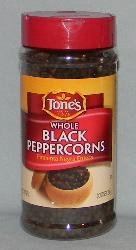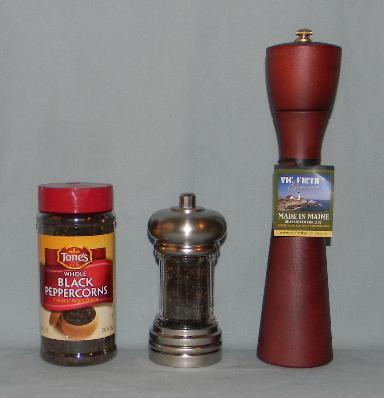
















Black Pepper, Peppercorns, and Peppercorn Grinders
Copyright © March 19, 2011 by Robert Wayne Atkins, P.E.
Revised September 28, 2018.
All Rights Reserved.
History of Black Pepper
 In today’s modern world most people do not give a second thought to many things that were once highly prized but which are relatively cheap today. Black pepper is one of those items. In the distant past wars were fought over black pepper. And the soldiers who fought in those wars were paid by giving them all the pepper they could carry. At that time pepper fetched a handsome price in the marketplace and it was considered to be a commodity that had real value just like silver or gold.
In today’s modern world most people do not give a second thought to many things that were once highly prized but which are relatively cheap today. Black pepper is one of those items. In the distant past wars were fought over black pepper. And the soldiers who fought in those wars were paid by giving them all the pepper they could carry. At that time pepper fetched a handsome price in the marketplace and it was considered to be a commodity that had real value just like silver or gold.
Black pepper is a good source of manganese and iron. It is also a powerful antioxidant. Black pepper helps the body to metabolize and digest food and it can help to prevent gas. It helps the stomach to digest fats and meat proteins, and it aids the body in the absorption of the nutrients and the vitamins in food. However, some people do not like black pepper because of its taste or because it upsets their stomach.
It takes a minimum of three years for a black pepper plant to grow peppercorns. And pepper is not easy to grow everywhere. It is similar to coffee and bananas. If you have the correct soil and environmental conditions then coffee, bananas, or pepper can be grown. But if you try to grow one of these crops in an unsuitable climate then you will not be successful.
Therefore, if your family enjoys the taste of black pepper on their foods, then you will need to store some of it because you will not be able to grow it yourself.
Shelf Life of Black Pepper and Other Spices
Peppercorns, cardamom, cloves, cinnamon sticks, cumin, and nutmeg have a reasonably long shelf life.
However, black pepper and most other spices are usually sold with a best-if-used-by date. This date is extremely conservative and the spice will not simply expire when that date is reached. In fact, some of the larger spice companies, such as McCormick, actually recommend that you continue to use a spice as long as that spice still has some of its original flavor. In other words, the potency and the flavor of the spice will gradually decline with the passage of time, but it is still safe to use. However, you would need to use a little more of the spice as it ages to obtain the same flavor results as when the spice was fresh.
Black pepper is created by grinding black peppercorns into fine, medium, or coarse ground pepper. Ground black pepper theoretically has a shorter shelf life than whole black peppercorns. Whole peppercorns should have an indefinite shelf life if they are stored in their original container in a cool, dark, dry environment. It is also possible to vacuum seal peppercorns using an ordinary food vacuum sealer.
Therefore the most logical way to store black pepper is in the form of whole black peppercorns. You will also need to purchase and store a pepper grinder.
Black Pepper Shelf Life Test: I had some "Tone's Brand" ground black pepper and some whole black peppercorns that had been in storage for more than ten years. The pepper did not have any printed expiration dates on the containers so I do not know exactly how old the pepper was. I only know that the pepper was at least ten years old. All the pepper was stored inside their original containers in an environment where the temperature remained between 60°F to 70°F all year (or 15.5°C to 21.1°C). I opened a container of the ground black pepper that had been in storage for more than ten years and my family gradually consumed all the black pepper. It still had a fresh smell and a fresh taste. I then opened a container of the whole black peppercorns that had been in storage for more than ten years and I gradually transferred the peppercorns into a pepper grinder. As we gradually ground the black peppercorns into pepper it still had a fresh smell and a fresh taste. My family enjoyed consuming that freshly ground black pepper with our meals. You will need to make your own decision about the quality of any ground black pepper or whole black peppercorns that you may have in storage.
Pepper Grinders
Pepper grinders may be made of wood, metal, plastic, or glass. But the grinding mechanisms inside these different pepper mills are all very similar. You remove the top of the pepper grinder, put some whole peppercorns inside the grinder, replace the top, and then rotate the grinding mechanism to grind the peppercorns into pepper which falls out the bottom of the pepper grinder.
Some pepper mills have a crank on the top. You hold the bottom of the pepper grinder in one hand above your food and you rotate the top crank with your other hand. Ground pepper falls out the bottom of the grinder onto your food.
 Some pepper mills are made in two parts: an upper and lower (see picture on right). You hold the lower half of the grinder in one hand and then rotate the upper half of the grinder with the other hand. Ground pepper falls out the bottom of the grinder onto your food.
Some pepper mills are made in two parts: an upper and lower (see picture on right). You hold the lower half of the grinder in one hand and then rotate the upper half of the grinder with the other hand. Ground pepper falls out the bottom of the grinder onto your food.
Both of the above pepper mills will do a good job of grinding peppercorns into pepper.
The major decision is how much you wish to invest in a pepper grinder. The more expensive grinders are usually of a higher quality. But the important part of a pepper grinder is its grinding mechanism. Therefore, you should look at the quality of the internal grinding mechanism before you make your final choice of a pepper grinder.
The following three items are shown in the picture on the right:
- Tone’s Whole Black Peppercorns (about $6.98 for 9 ounces at Walmart). At Walmart you can purchase ground black pepper for $1.98 for 2.62 ounces, or approximately $0.756 per ounce. On the other hand, whole black peppercorns can be purchased for almost the same price or about $0.776 per ounce. Therefore, whole peppercorns would definitely be the better value if you are purchasing pepper for a potential future hard times tragedy event.
- Metal Peppercorn Grinder with a Clear Glass Center (about $8 at Walmart and it is sold with peppercorns inside). This is good pepper mill. It yields a medium grind of pepper and the grind can be increased or decreased a little bit. The glass center area allows you to visually see how many peppercorns are remaining inside the mill so you will easily know when it is time to add more peppercorns.
- Wood Peppercorn Grinder made by Vic Firth in the State of Maine, USA. This is an excellent pepper mill. The top nut can be turned clockwise to yield a very fine grind of pepper, or it can be rotated counterclockwise to yield a coarser grind of pepper.
I do not recommend the small pepper grinders that are sold in the spice racks with a small amount of peppercorns in them. The majority of these little pepper mills are single use items and they cannot be easily opened and refilled.
Respectfully,
Grandpappy.
Grandpappy's e-mail address is: RobertWayneAtkins@hotmail.com




































 In today’s modern world most people do not give a second thought to many things that were once highly prized but which are relatively cheap today. Black pepper is one of those items. In the distant past wars were fought over black pepper. And the soldiers who fought in those wars were paid by giving them all the pepper they could carry. At that time pepper fetched a handsome price in the marketplace and it was considered to be a commodity that had real value just like silver or gold.
In today’s modern world most people do not give a second thought to many things that were once highly prized but which are relatively cheap today. Black pepper is one of those items. In the distant past wars were fought over black pepper. And the soldiers who fought in those wars were paid by giving them all the pepper they could carry. At that time pepper fetched a handsome price in the marketplace and it was considered to be a commodity that had real value just like silver or gold. Some pepper mills are made in two parts: an upper and lower (see picture on right). You hold the lower half of the grinder in one hand and then rotate the upper half of the grinder with the other hand. Ground pepper falls out the bottom of the grinder onto your food.
Some pepper mills are made in two parts: an upper and lower (see picture on right). You hold the lower half of the grinder in one hand and then rotate the upper half of the grinder with the other hand. Ground pepper falls out the bottom of the grinder onto your food.
